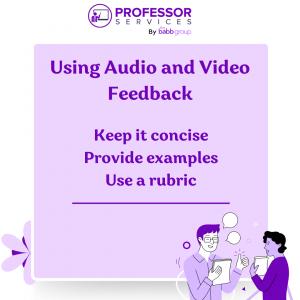As more and more colleges and universities move to online and hybrid learning, professors need to find ways to provide meaningful feedback to students. One way to do this is by using video and audio feedback. Read on for the benefits of using video and audio feedback and how professors can use these tools effectively.
Video and audio feedback can be excellent ways for college professors to provide feedback to their students. For professors, it can be easier and faster to speak as opposed to writing. You can employ tone and nuance more efficiently in your feedback which might make the feedback more effective and meaningful. With a student’s work open on your computer, you can record your screen and point to or highlight parts of the work you refer to. Google’s screencastify plugin makes it simple to screen record with student assignments.
Audio feedback allows students to hear your tone and intended delivery. Audio/video feedback is beneficial for fully online asynchronous courses. It allows students to connect with professors more personally than typed comments might provide.
Benefits of Using Video and Audio Feedback
Personalization: Video and audio feedback allow professors to communicate with students in a more personal and engaging way. This can help students feel more connected to their instructor and improve their learning experience.
Clarity: With video and audio feedback, professors can provide more detailed explanations of their comments and suggestions. This can help students better understand their mistakes and how to improve.
Efficiency: Video and audio feedback can be faster and more efficient than typing comments. Professors can record and send their feedback to students, saving time and effort.
Flexibility: Video and audio feedback can be accessed by students at any time, which allows for more flexibility in when and where students can review their feedback.
Accessibility: Audio feedback is a helpful tool for students who prefer hearing over reading or who experience visual issues. Be sure to use transcripts or closed captioning on all media-based feedback for students who prefer text and reading or who experience hearing issues.
How Professors Can Use Video and Audio Feedback

Use screen recording software: Professors can use screen recording software to record themselves going through a student’s assignment and providing feedback. This allows for a more visual explanation of comments and suggestions.
Use audio recording software: If professors prefer to provide audio feedback, they can use software such as Audacity to record their comments and suggestions. This can be especially helpful for students who are visual learners and prefer to listen to feedback rather than read it.
Keep it concise: When providing video and audio feedback, it’s essential to keep it brief and focused on the most critical points. This will help students better understand the feedback and not become overwhelmed by too much information.
Provide examples: When providing feedback, professors can use examples to help students better understand their comments and suggestions. This can be especially helpful for students struggling with a particular concept.
Use a rubric – A rubric can help ensure that feedback is consistent and focuses on the most critical aspects of an assignment. This can also help students better understand how their work will be evaluated.
Video and audio feedback can be powerful tools for professors in online classrooms. By using these tools, professors can provide more personalized and engaging feedback, improve clarity and efficiency, and offer more flexibility to students. By following these tips, professors can effectively use video and audio feedback to help their students succeed.
Angela
Latest posts by Angela (see all)
- The Art of Connection: Networking and Professionalism in Academia - July 25, 2024
- Got the Teaching Job? Now, You Need To Attend the Faculty Training - July 1, 2024
- Higher Education Trends: Insights from Our COO, Sheila Fry - June 20, 2024